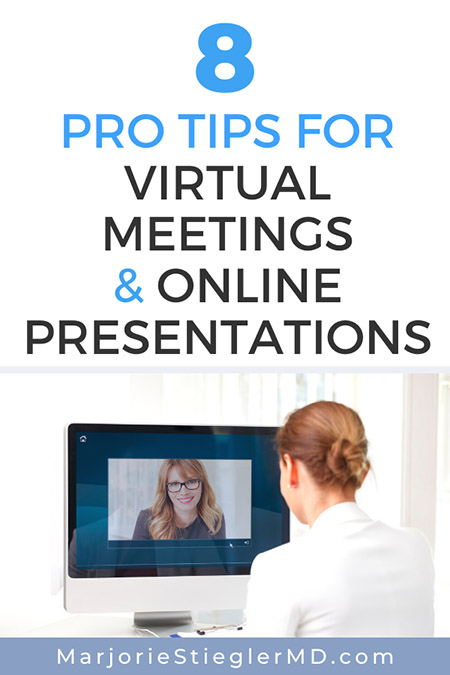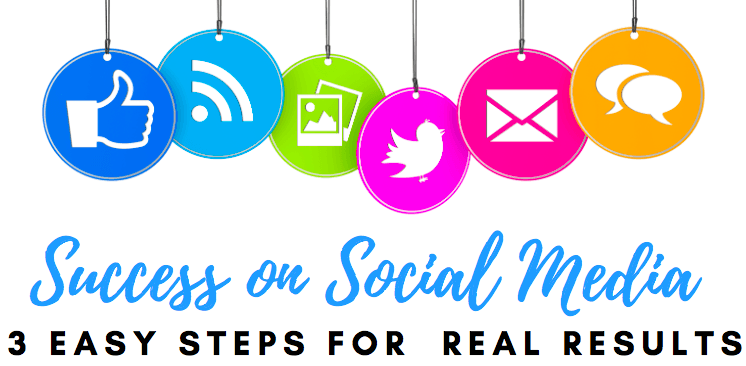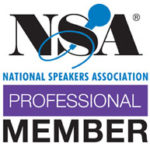Hey guys, today we’re going to be talking about how to really rock it when you’re presenting virtual meetings, or live webinars or otherwise have some high stakes professional activity online.
In This Episode of The Career Rx We’ll Discuss:
- How the world is more virtual than ever before.
- Virtual meeting etiquette and how it can directly impact your future career growth.
- 8 professional tips for virtual meetings, presentations and webinars
- Tools and resources you can use when hosting online team meetings and other professional online presentations.
LISTEN TO THIS EPISODE:
SUBSCRIBE TO THE CAREER RX PODCAST:
Want to get access to the latest podcast? Subscribe on your preferred podcast player…
Apple Podcast | Google Podcast | Spotify | TuneIn + Alexa | iHeart Radio
TRANSCRIPT AND SHOW NOTES (8 Pro Tips for Virtual Meetings, Presentations, and Webinars)
This episode is the result of a question that came through in one of my online sessions with the Association of Women Surgeons Signature Speakers Series.
Some of you may know that I’m the coach this year for the very first ever Signature Speaker Series training program that is hosted by the Association for Women Surgeons.
Of course, COVID strikes and many people’s events are canceled. So, here you have these fantastic women surgeons who have been working very hard to elevate their professional careers by getting more time on stage.
I’ve been coaching them all year, and now many of the things they’ve been working towards have either been cancelled or are going virtual.
One of the questions they had for me at one of our Q&A sessions is:
How can you bring across that professionalism and bring your best, most engaged self to delivering a talk online?
I’m going to address that today. I’ll also expand on this topic and discuss live webinars and virtual meetings, which are now primary ways of communicating.
The World is Now Virtual
Webinars, of course, are not new.
We’ve had webinars around for a long time. Zoom meetings, FaceTime and video calls are not new, but they are increasing now in frequency.
We’re also seeing a lot of things that are much more high stakes being converted to virtual events. For example, major academic conferences are now being held entirely virtually, which are high-level productions.
These are intended to be face-to-face events, with people delivering impactful material – your Grand Rounds, commencement addresses and other types of high caliber events are going virtual.
Certainly, if you are in an office or work-from-home environment your whole day has gone virtual.
I think what’s new right now and will most likely stick around in the future will be major conferences, Grand Rounds and things of that nature.
Virtual Meeting Etiquette is Imperative
If you have a physician side gig, you are likely already aware of the benefits of webinars. Webinars have major marketing benefits for any business, but specifically for our side gig businesses.
If you have a more traditional practice, you are perhaps doing some telemedicine and maybe that’s going to stay part of your practice. You’re going to be interfacing with patients online instead of in person.
Many of the physicians I work with have an online coaching or online course business. If this is you, you’re aware you need to have a good presence on the camera.
Those with office jobs are having face to face video meetings all day long. These video calls are how you show up professionally and they do have implications not only for how you succeed in that moment, but for your overall career development.
If this is a long term phenomenon and sticks around, it will impact your future development, regardless of your career path. Examples:
- Speaking career, impacting the future invitations that you get
- Side gig and other business
- Telemedicine
- Online coaching, impacting your repeat customers, or your referral base
- Office job, your video presence impacts your promotional and growth track in your work
Right now you have the opportunity to master your professionalism in these virtual meetings.
By following these eight easy tips I have below, you will be head and shoulders above the vast majority of your colleagues.
Many of these tips are things people don’t think about or don’t put the effort to do well, but these make a huge difference!
When you start to focus on this advice and pay attention to whether other people are doing it, you will really notice the difference between people who just show up and turn on their webcam, and people who have a really polished professional presence on virtual meetings, live webinars, and other online presentations.
By the way, some of these tips contain recommendations for products. I’ll make it easy to find those through my Amazon Affiliate links, which also means I earn a small commission if you buy one. As always, I only recommend things I truly believe in and have used myself. Full disclosure here.
8 Pro Tips for Virtual Meetings, Presentations and Live Webinars
1. Look at the Camera – Not the Screen
One of the easiest and impactful tips for virtual meetings and presentations is to look at the camera and not at the screen. This one takes a lot of practice, as it does not always come naturally.
Don’t look at your colleagues (in the other windows).
Don’t look at yourself (It can be very tempting, as you’re seeing yourself on the screen).
If you’re doing this you aren’t making eye contact, you’re actually looking down.
I realized that you don’t get that same feedback from someone making eye contact with you. That’s why it’s more human nature to look at the screen and to actually look at your colleagues. However, if you want them to experience eye contact from you, you’ve got to look into the camera just like reporters on TV.
That may feel a little bit strange, especially because your colleagues are right there below you. But that is the best way to make a real solid connection across this digital space.
Pro tip: Adjust the settings of your platform (Zoom, WebEx, etc) to move the thumbnails of slides or of your colleagues to the very top, or as close to the camera as possible.
Look into the camera, not at the screen.
2. Set Your Camera at Eye Level or Above
A lot of people use laptops for their virtual meetings and presentations, so their webcams are often relatively low on their desks.
That’s usually slightly lower than your head and shoulders. So, what ends up happening is people are looking right up your nose!
If you simply get a box (an Amazon box or something like that) and stick it on your desk you will raise your laptop up so it’s at eye level to you.
This will go a long way and put you nicely in the frame, so you have well-framed proportions. You want to have your head and some of your shoulders in the view. You’ll want to be straight in view.
Note: You shouldn’t be able to see your entire upper body and too much of the room around you.
So, take a few moments to see what you look like in that frame before you start your meeting.
Pro Tip: Have a neutral background for your virtual meetings and presentations that isn’t distracting.
- Set up a neutral background or even a staged background so that you have something of interest but that isn’t distracting.
- Make sure the background isn’t an open bathroom door, your laundry hamper or whatever happens to be around.
- Have something that looks professional (ideally, it’s not a door or closet). Ideally, it’s a plain wall, perhaps with some simple art.
- On Zoom and some other online platforms, you can get digital backgrounds where it’s similar to being on a green screen, so you can have something else show up behind you. You can download additional templates on Canva!
All in all, do spend some time thinking about having the camera at the right level, the proportions of yourself in the frame, and what else is in the frame (your background).
3. Consider Standing Up for your Virtual Meetings & Presentations
Think about using a standing desk or standing desk adapter that you can put on top of your existing desk so you can boost it up. Flexispot and Vivo are solid choices, but there are many options.
So if you can, just stand up! Why?
Standing up gives you more energy. You’re much more likely to use more animated facial expressions and hand gestures the same way you might if you’re actually at a podium delivering the talk.
When you’re sitting down, things seem to be a little bit more muted.
If you want to come across in a positive, professional manner to your audience, standing up – having that high energy, being framed well, and looking right at the camera – that will go a long way towards a strong connection.
4. Get Yourself Some Good Lighting
You want to ideally have natural lighting, but if that’s not possible, at least make sure the lighting is coming from the front.
You do not want to be backlit, which makes you look dark.
You also don’t want to have overhead lighting which casts a really awful shadow on you giving you dark circles under your eyes.
You want to put the lighting directly in front of you, ideally a window natural light.
If you can’t do that, invest in a simple light ring, or some regular lamps, but just move them to the front side of the room so they’re in front of you. These should be symmetric so you’re not having those shadows.
That’s where the light ring I think is really superior to most lamps and other lighting solutions.
If you don’t know what a light ring is, you can check it out here.
You will look a million times better than if you have that overhead lighting or if you are backlit, so invest in some decent lighting. It makes a big difference.
5. Have Good Quality Sound for Your Virtual Meetings
Now, beyond what you look like is what you sound like.
Of course, people are going to be looking at you – your face and expressions, your emotions, your gestures – but they do want to have good sound quality.
Although your laptop may have a pretty decent built-in microphone, almost always an external microphone is better.
You can set this up in a variety of different ways. I have a handful of different devices:
- A Jabra, which I use for work (like a conference room type external microphone)
- I have a Snowball, which I use to record this podcast
A simple external microphone will go a long way.
This could even be Bluetooth or something that you’re wearing. Just be very mindful of any kind of friction of your microphone (if you have a headset), making sure you’re not breathing like Darth Vader! You don’t want to have those breathing sounds, popping when you are speaking, or echoes.
Also, be mindful of the other things you might be doing. If you have notes, a chair on wheels or really anything else that could be distracting to the audience. Even a mouse click or typing a lot can come across loud and clear in your online meeting or webinar.
So, make sure you have a good high-quality mic – most likely something that is external to your computer.
You can get these high-quality microphones inexpensively. My favorite is this really inexpensive and highly portable little Samson Go Mic. It’s plug and play. Stick it in the USB port and you’re ready to go. I’ve been using it to record online courses for something like six years now.
6. Avoid Mentions of Time to Keep Content Evergreen and Globally Relevant.
If you’re speaking to a professional, perhaps global audience – something that’s going to be streamed in different time zones – you’ll want to avoid mentions of time.
For example: Don’t say “good morning” or mention a specific day of the week. If you avoid any reference to time or day your content will be more applicable to a larger global audience that could be joining.
Also, if you’re making evergreen content that’s intended to have a replay that can be watched on-demand, it will naturally be watched at a different time.
Now, obviously, this is not a huge deal. People are well aware when they’re watching something that’s on-demand that it occurred in the past. People are also aware that the world has time zones and that you’re speaking from wherever you’re speaking. So it’s not a huge deal, but again, it’s these little things that when you add them up, they really level you up.
So avoid mentions of date and time.
7. Engage with Your Audience (You Can!)
I encourage you to engage with your audience. You might feel like you can’t because they’re on the other side, but ask the person or the group that you’re presenting to, to have their webcams on as well.
Going back to tip 2, don’t look at them but just knowing they’re there, while you’re looking into the camera will offer a feeling of engagement. This will come through in the way that you talk and present.
Also, make sure to use the chat strategically.
Most platforms have an ability to use chat and sometimes even interactive polls, quizzes, word clouds and things like that.
Take a moment to familiarize yourself with the platform you’re using and try to use some of these tools strategically.
You can use the chat in two ways:
- Ask people to answer questions. The best way to do this is to set it up so that they have just a one or two words to type back to you. If you have to type a whole dissertation or figure out what to write, then they won’t. So you want to make it simple. For example, ask them about preferences between just 2 or 3 choices. You articulate the choices, and then ask them to type a single word that represents the choice, or you can label them choices A,B,C.
- Share resources. Have them ready to go, queued up in advance so you can send them to your audience through the chat with a quick click. Use a direct link to any resources you’re mentioning. That makes things run smooth and easy. Depending on the software, you may be able to send attachments, text, URLs, and more.
8. Set Expectations and Ground Rules
At the beginning of your virtual meetings and presentations, set some expectations, both for yourself and for others.
At work, the ground rule I like to set when I’m running a meeting is I don’t want apologies from attendees for things like kids and pets and doorbells or someone mowing the lawn – because we’re all working from home!
I don’t want for people to apologize for being human. So there’s no apologies and I set that ground rule right upfront. So they know I’m not going to be apologizing if something like that happens on my end, and I don’t want them to either.
It’s also a good idea to set some more mundane ground rules for your virtual meetings/presentations.
For example:
- Asking everybody to be on mute unless they’re speaking
- Letting them know how to participate, i.e. raise a virtual hand
- Letting them know whether you want their cameras on
- Asking them to save all questions for the end
Those kinds of housekeeping items go a mighty long way when you set that up right at the beginning.
If You have a Larger Online Presentation:
Of course, if you’re giving a ‘big deal’ presentation like a commencement address, you may not want to mention things like that. This has to be context specific.
I would never open a presentation by setting ground rules if it’s a ‘big deal’ event. A polished presentation – something that has a carefully planned engaging opening. That’s stealing your own thunder.
However, in today’s day and age, if you’re having a meeting, or something that’s business-oriented, setting ground rules can go a long way towards connecting with your audience as it shares that human experience we’re all going through, which frankly, is a little different.
Recap: Your 8 Tips for virtual meetings, presentations and webinars.
- Look at the camera, not at the screen.
- Set your camera up at eye level and get yourself framed well.
- Increase your energy by standing up.
- Have good natural lighting coming from the front.
- Ensure you have good quality sound (an external microphone that works well).
- Avoid mentions of time to keep content evergreen and globally relevant.
- Strategically engage with your audience & make sure their webcams are on!
- Set ground rules at the beginning, so people’s expectations are managed, both for you and for them.
I hope this has helped you to get on camera and feel confident that you can deliver not only really great content, but that you can look like a pro while you’re doing it.
If you are taking this time to truly invest in your professional self, really up your game, for your presentations, your public speaking and how you connect and communicate, then I hope that you’ll come check out The Speaking Prescription course. I think you’ll find it really valuable.
There has never been a more important time to really master how to have a great presence at virtual meetings, how to communicate effectively, and to connect effectively across that digital divide.
Here are some more resources to help you to present effectively and bring your best self.
- 10 Professional Tips to Improve Your Public Speaking Skills
- 5 Powerful Tips to Nail Your Public Speaking Q&A Session
- 10 Tips for Physician Speakers To Deliver Better Presentations
- Professional Speaking: How To Set Your Price
- 4 Unique Ways Speaking Helps Career Advancement
- Not Getting Speaking Invitations? You Might Be Wrong About Why
If you have tips for virtual meetings presentations or webinars that you haven’t heard in this episode, I would love to hear from you. Please do email them to me, or share this podcast on social media and add your tip to it and tag me. I would just love to hear from you like that!
–
Thanks for joining me on this episode of The Career Rx!
Please be sure to subscribe and leave me a review on Apple Podcast, Google Podcast or whatever podcast player you’re using to listen today. Also, be sure to send me your questions so I can answer them and give you a shout out on a future episode.
Bye for now,
Marjorie










